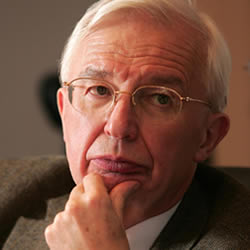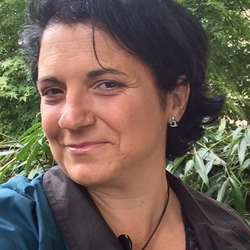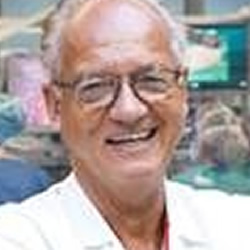
University of Strasbourg Graduate and 1987 recipient of the Nobel Prize in Chemistry
Speaking Wednesday 26th August
Steps Towards Life: Chemistry!
The evolution of the universe has generated more and more complex forms of matter through self-organization, from particles up to living and thinking matter. Self-organization is the process by which steps towards life and thought have emerged. Animate as well as inanimate matter, living organisms as well as materials, are formed of molecules and of the organized entities resulting from the interaction of molecules with each other. Chemistry provides the bridge and unravels the steps from the molecules of inanimate matter and the highly complex molecular architectures and systems which make up living and thinking organisms. The field of chemistry is the universe of all possible structures and transformations of molecular matter, of which those actually realized in nature represent just one world among all the worlds that await to be created. Conceptual considerations on science in general will be presented.

Head of the Children’s Rights and Sport Values Department, Council of Europe
Speaking Thursday 27th August
Children's Rights: the key to a future-proof Europe
The very first Article of the Universal Declaration of Human Rights states: “All human beings are born free and equal in dignity and rights.” Yet children’s dignity and rights are frequently overlooked and far too often violated. Building upon that Universal Declaration, the international community has elaborated a set of norms aiming at protecting human dignity, first and foremost, through the protection of human rights and freedoms. The UN Convention on the Rights of the Child adopted in 1989 was both a reminder and a revolution.
A reminder, because children did not need to wait for the Convention as their rights were already recognised as befalling every human being. Previous texts had established States’ duty to provide children with special care and attention. But the Convention was also a revolution, because it brought States to recognise that children are not a homogenous group of dependent people but individual holders of rights. The Convention also recalls that, while the family has a primary responsibility in the protection and education of children, the State is the guarantor of the implementation of all children’s rights.
Thirty years after the adoption of the Convention on the Rights of the Child and over 100 years after the Universal Declaration, respect of the child’s dignity and children’s rights, continue to come as an afterthought, instead of being embedded in all our actions and decisions.
The latest revolution, the information society revolution, has occurred at the expense of millions of children’s dignity and integrity. One of the critical challenges today is globalisation of Internet and the absence of an ethical code governing its use or of a truly global Internet governance.
To address the challenges linked to the evolution of technology, we must build our action upon three pillars.
1) The child’s dignity: The Child’s dignity cannot be an afterthought. In all human enterprises, it must be there by design. Whether it’s to develop a policy, to adopt a law, to design a software, to build a business, to run a sport club or to guide a religious community: the possible impact on children must be assessed and children’s rights protected, promoted and respected.
2) A holistic approach: In our journey to protect the child’s dignity, the UN Convention on the Rights of the Child must be our compass. To effectively address on-line sexual exploitation, our backpack must include our tools to prevent, to protect and to prosecute all violations of children's rights.
3) Clear responsibilities and empowerment to act: The child’s dignity is wherever the child is: on line and off line, within the family, at the hospital, within a religious community, in an orphanage, in a sports arena or in a detention facility. We are individually and collectively responsible for creating the conditions for children to develop to their full potential, “in an atmosphere of happiness, love and understanding” (as the Convention says).
We all must feel empowered and up to the task. Much more needs to be done to educate, train and empower all those in contact with children.
Clearly, it would be reasonable to expect the evolution of technology to be in the humankind’s best interest. The fact is that we are entering the era of Artificial Intelligence without even realising its impact in our lives, our rights, our dignity.
We all have a huge role to play to make sure that algorithms do not replace conscience, and that science and technology serve first and foremost our very essence: our dignity. And this starts by protecting the child’s dignity, everywhere, at all times.

Founding Director of the IRCAD (Institute for Research into Cancer of the Digestive System) and lead practitioner on the Lindbergh operation
Speaking Friday 28th August
Imaging, robotics and artificial intelligence: the 3 weapons to achieve an intelligent surgery
Technological progress applied to minimally invasive surgery will inevitably lead to the concept of automated surgery, mimicking the evolution of aeronautics and more recently the automotive industry.
Three joint developments corroborate this vision: virtual 3D imaging, robotics, and artificial intelligence.
- 3D imaging uses virtual reality algorithms and allows a precise analysis of the anatomy of the organ to be operated, but also an interactivity between the image and the surgeon which allows a perfect, personalized simulation of the surgical procedure. Additionally, the superimposition of the virtual image on the real image leads to the concept of augmented reality and subsequently to transparent vision.
- Today, surgical robotics, i.e., simple telemanipulation using a master/slave relationship, will be enriched with virtual reality and augmented reality data, standing for a major and compulsory step towards procedural assistance (surgical GPS), then towards automated surgery.
- Finally, artificial intelligence, which has the ability to analyze millions of data, will support surgical decision-making, allowing to avoid "an isolated surgeon’s strategy", a scenario which involves too much emotional data.
When integrated into the robotic system, artificial intelligence will then make it possible to manage the surgical act, for instance stopping any procedure that goes beyond validated standards, and the surgical maneuver subsequently becomes semi-automatic before being totally autonomous.
The surgical revolution is underway-- surgical science and science fiction are coming together.




